MNG93100: Report on Stakeholder Engagement in Engineering Projects
VerifiedAdded on 2023/03/17
|10
|2355
|62
Report
AI Summary
This report examines the critical role of stakeholder engagement in engineering projects, emphasizing the potential negative impacts of neglecting community and stakeholder involvement. It presents case studies, including the Tweed water mining alliance, the Gold Coast City Council, and the Adani coal mine, to illustrate the complexities of stakeholder relations and the importance of stakeholder-centric project management. The report highlights the need for building trust, clear communication, and proactive consultation to avoid conflicts and ensure project success. It also discusses the expectations of stakeholders, the benefits of agile collaboration, and the principles of effective project management, concluding that building long-lasting relationships with stakeholders is vital for project integrity and reputation. The report is based on the MNG93100 Stakeholder Engagement in Engineering module and uses Harvard referencing.
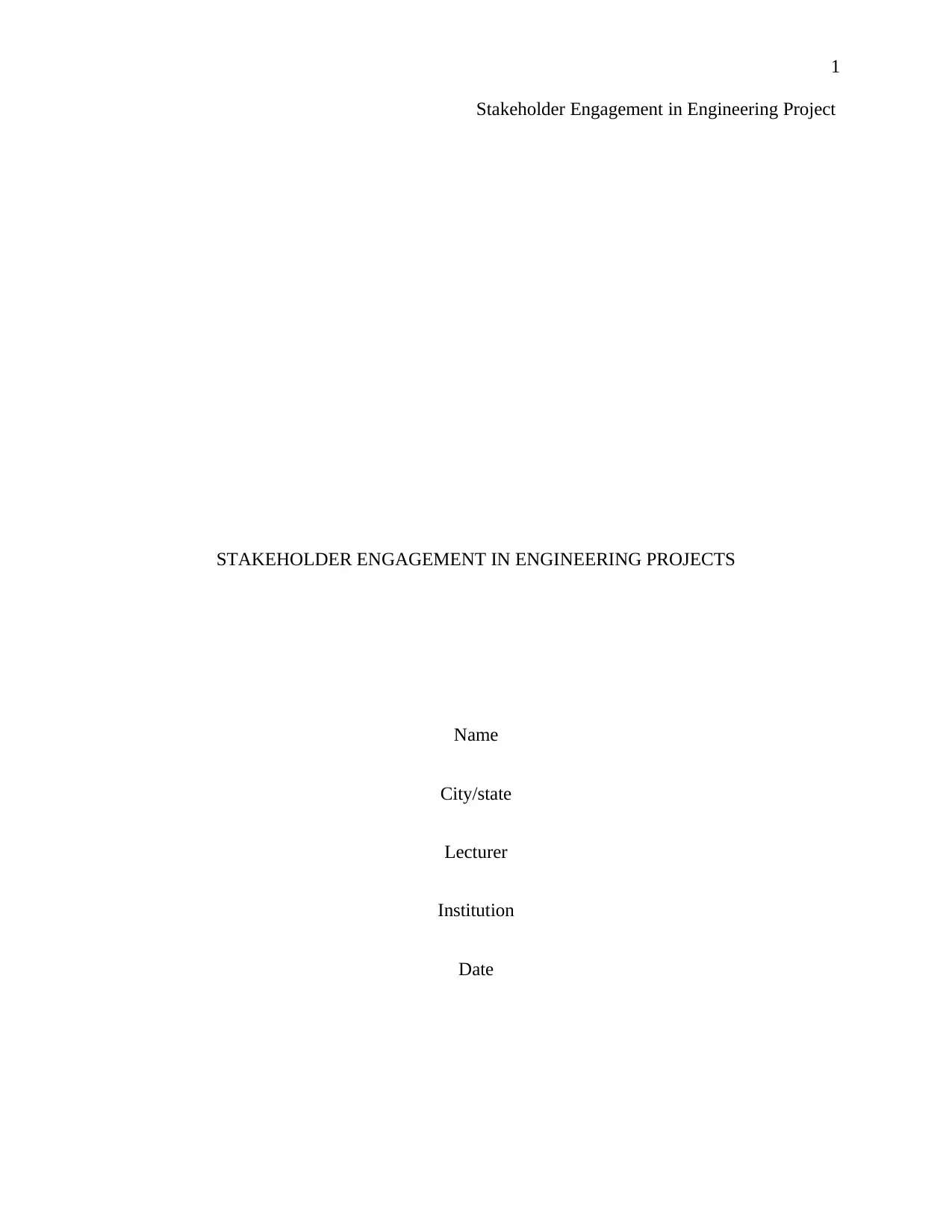
1
Stakeholder Engagement in Engineering Project
STAKEHOLDER ENGAGEMENT IN ENGINEERING PROJECTS
Name
City/state
Lecturer
Institution
Date
Stakeholder Engagement in Engineering Project
STAKEHOLDER ENGAGEMENT IN ENGINEERING PROJECTS
Name
City/state
Lecturer
Institution
Date
Paraphrase This Document
Need a fresh take? Get an instant paraphrase of this document with our AI Paraphraser
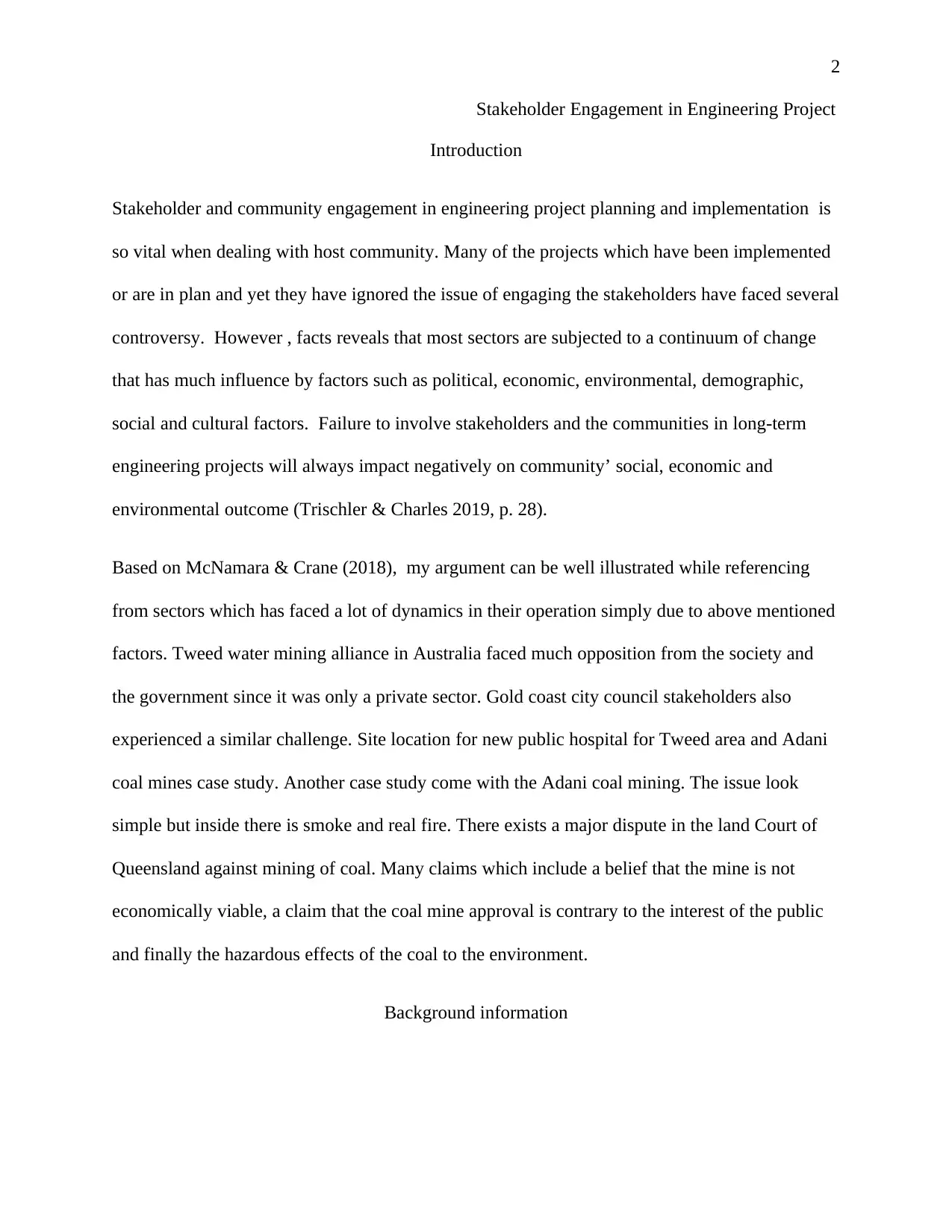
2
Stakeholder Engagement in Engineering Project
Introduction
Stakeholder and community engagement in engineering project planning and implementation is
so vital when dealing with host community. Many of the projects which have been implemented
or are in plan and yet they have ignored the issue of engaging the stakeholders have faced several
controversy. However , facts reveals that most sectors are subjected to a continuum of change
that has much influence by factors such as political, economic, environmental, demographic,
social and cultural factors. Failure to involve stakeholders and the communities in long-term
engineering projects will always impact negatively on community’ social, economic and
environmental outcome (Trischler & Charles 2019, p. 28).
Based on McNamara & Crane (2018), my argument can be well illustrated while referencing
from sectors which has faced a lot of dynamics in their operation simply due to above mentioned
factors. Tweed water mining alliance in Australia faced much opposition from the society and
the government since it was only a private sector. Gold coast city council stakeholders also
experienced a similar challenge. Site location for new public hospital for Tweed area and Adani
coal mines case study. Another case study come with the Adani coal mining. The issue look
simple but inside there is smoke and real fire. There exists a major dispute in the land Court of
Queensland against mining of coal. Many claims which include a belief that the mine is not
economically viable, a claim that the coal mine approval is contrary to the interest of the public
and finally the hazardous effects of the coal to the environment.
Background information
Stakeholder Engagement in Engineering Project
Introduction
Stakeholder and community engagement in engineering project planning and implementation is
so vital when dealing with host community. Many of the projects which have been implemented
or are in plan and yet they have ignored the issue of engaging the stakeholders have faced several
controversy. However , facts reveals that most sectors are subjected to a continuum of change
that has much influence by factors such as political, economic, environmental, demographic,
social and cultural factors. Failure to involve stakeholders and the communities in long-term
engineering projects will always impact negatively on community’ social, economic and
environmental outcome (Trischler & Charles 2019, p. 28).
Based on McNamara & Crane (2018), my argument can be well illustrated while referencing
from sectors which has faced a lot of dynamics in their operation simply due to above mentioned
factors. Tweed water mining alliance in Australia faced much opposition from the society and
the government since it was only a private sector. Gold coast city council stakeholders also
experienced a similar challenge. Site location for new public hospital for Tweed area and Adani
coal mines case study. Another case study come with the Adani coal mining. The issue look
simple but inside there is smoke and real fire. There exists a major dispute in the land Court of
Queensland against mining of coal. Many claims which include a belief that the mine is not
economically viable, a claim that the coal mine approval is contrary to the interest of the public
and finally the hazardous effects of the coal to the environment.
Background information
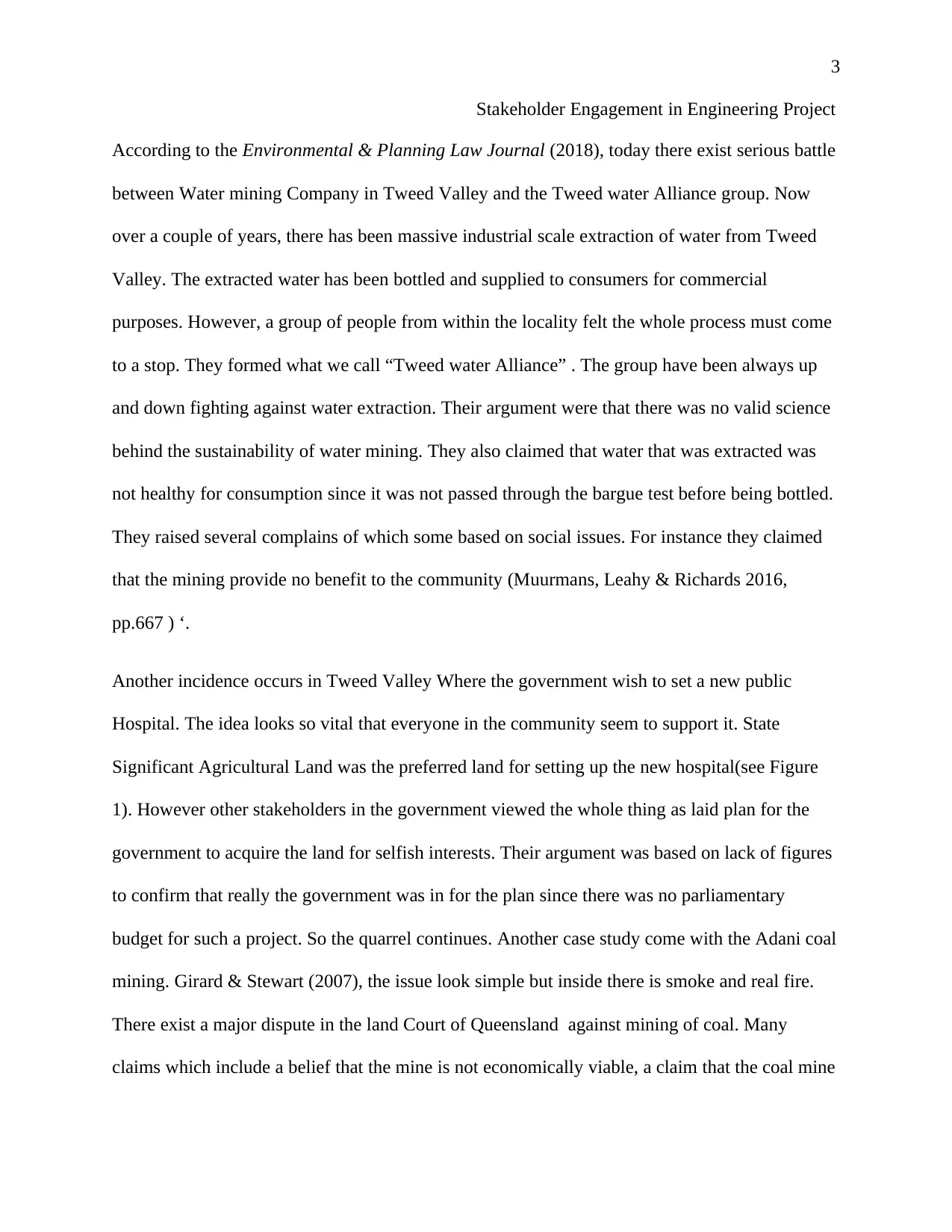
3
Stakeholder Engagement in Engineering Project
According to the Environmental & Planning Law Journal (2018), today there exist serious battle
between Water mining Company in Tweed Valley and the Tweed water Alliance group. Now
over a couple of years, there has been massive industrial scale extraction of water from Tweed
Valley. The extracted water has been bottled and supplied to consumers for commercial
purposes. However, a group of people from within the locality felt the whole process must come
to a stop. They formed what we call “Tweed water Alliance” . The group have been always up
and down fighting against water extraction. Their argument were that there was no valid science
behind the sustainability of water mining. They also claimed that water that was extracted was
not healthy for consumption since it was not passed through the bargue test before being bottled.
They raised several complains of which some based on social issues. For instance they claimed
that the mining provide no benefit to the community (Muurmans, Leahy & Richards 2016,
pp.667 ) ‘.
Another incidence occurs in Tweed Valley Where the government wish to set a new public
Hospital. The idea looks so vital that everyone in the community seem to support it. State
Significant Agricultural Land was the preferred land for setting up the new hospital(see Figure
1). However other stakeholders in the government viewed the whole thing as laid plan for the
government to acquire the land for selfish interests. Their argument was based on lack of figures
to confirm that really the government was in for the plan since there was no parliamentary
budget for such a project. So the quarrel continues. Another case study come with the Adani coal
mining. Girard & Stewart (2007), the issue look simple but inside there is smoke and real fire.
There exist a major dispute in the land Court of Queensland against mining of coal. Many
claims which include a belief that the mine is not economically viable, a claim that the coal mine
Stakeholder Engagement in Engineering Project
According to the Environmental & Planning Law Journal (2018), today there exist serious battle
between Water mining Company in Tweed Valley and the Tweed water Alliance group. Now
over a couple of years, there has been massive industrial scale extraction of water from Tweed
Valley. The extracted water has been bottled and supplied to consumers for commercial
purposes. However, a group of people from within the locality felt the whole process must come
to a stop. They formed what we call “Tweed water Alliance” . The group have been always up
and down fighting against water extraction. Their argument were that there was no valid science
behind the sustainability of water mining. They also claimed that water that was extracted was
not healthy for consumption since it was not passed through the bargue test before being bottled.
They raised several complains of which some based on social issues. For instance they claimed
that the mining provide no benefit to the community (Muurmans, Leahy & Richards 2016,
pp.667 ) ‘.
Another incidence occurs in Tweed Valley Where the government wish to set a new public
Hospital. The idea looks so vital that everyone in the community seem to support it. State
Significant Agricultural Land was the preferred land for setting up the new hospital(see Figure
1). However other stakeholders in the government viewed the whole thing as laid plan for the
government to acquire the land for selfish interests. Their argument was based on lack of figures
to confirm that really the government was in for the plan since there was no parliamentary
budget for such a project. So the quarrel continues. Another case study come with the Adani coal
mining. Girard & Stewart (2007), the issue look simple but inside there is smoke and real fire.
There exist a major dispute in the land Court of Queensland against mining of coal. Many
claims which include a belief that the mine is not economically viable, a claim that the coal mine
⊘ This is a preview!⊘
Do you want full access?
Subscribe today to unlock all pages.

Trusted by 1+ million students worldwide
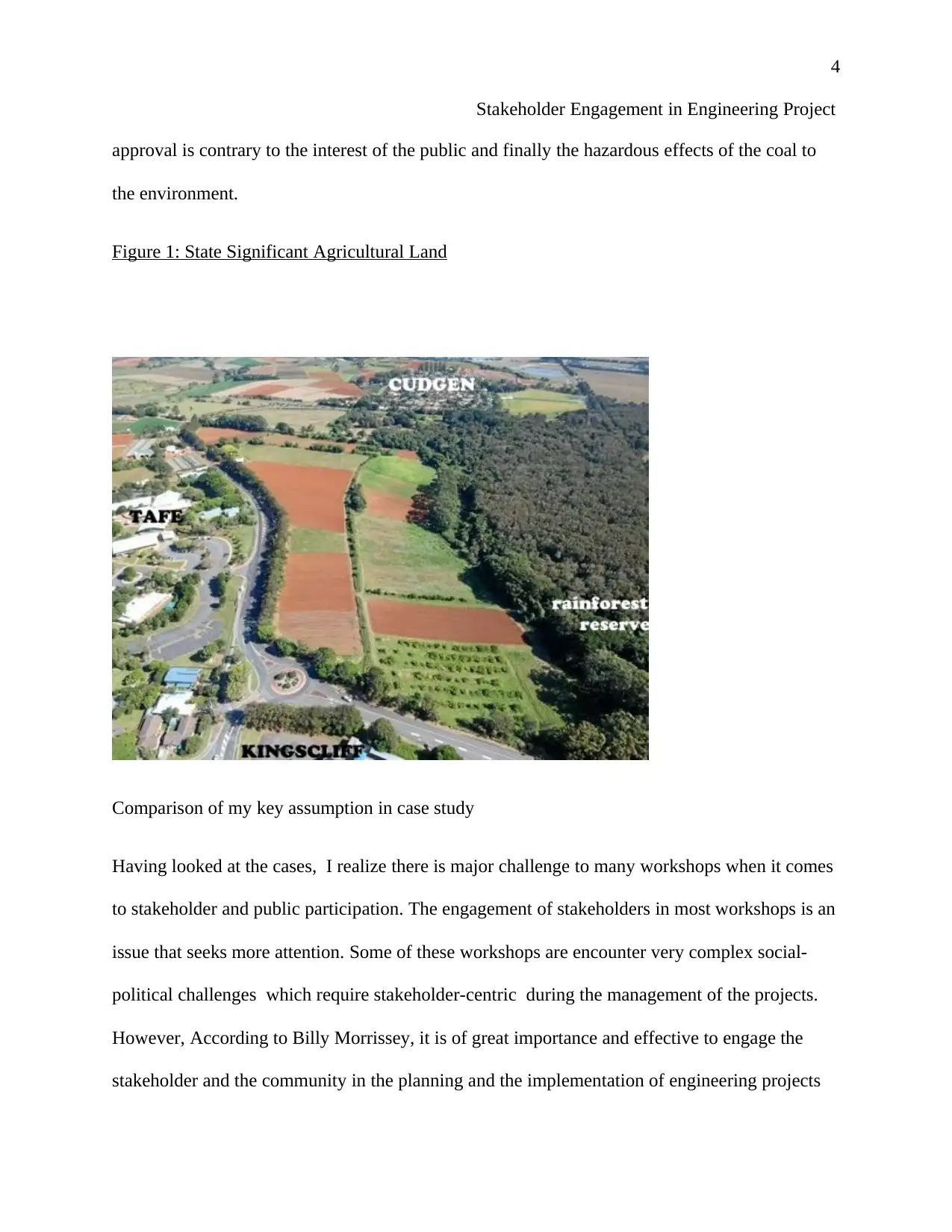
4
Stakeholder Engagement in Engineering Project
approval is contrary to the interest of the public and finally the hazardous effects of the coal to
the environment.
Figure 1: State Significant Agricultural Land
Comparison of my key assumption in case study
Having looked at the cases, I realize there is major challenge to many workshops when it comes
to stakeholder and public participation. The engagement of stakeholders in most workshops is an
issue that seeks more attention. Some of these workshops are encounter very complex social-
political challenges which require stakeholder-centric during the management of the projects.
However, According to Billy Morrissey, it is of great importance and effective to engage the
stakeholder and the community in the planning and the implementation of engineering projects
Stakeholder Engagement in Engineering Project
approval is contrary to the interest of the public and finally the hazardous effects of the coal to
the environment.
Figure 1: State Significant Agricultural Land
Comparison of my key assumption in case study
Having looked at the cases, I realize there is major challenge to many workshops when it comes
to stakeholder and public participation. The engagement of stakeholders in most workshops is an
issue that seeks more attention. Some of these workshops are encounter very complex social-
political challenges which require stakeholder-centric during the management of the projects.
However, According to Billy Morrissey, it is of great importance and effective to engage the
stakeholder and the community in the planning and the implementation of engineering projects
Paraphrase This Document
Need a fresh take? Get an instant paraphrase of this document with our AI Paraphraser
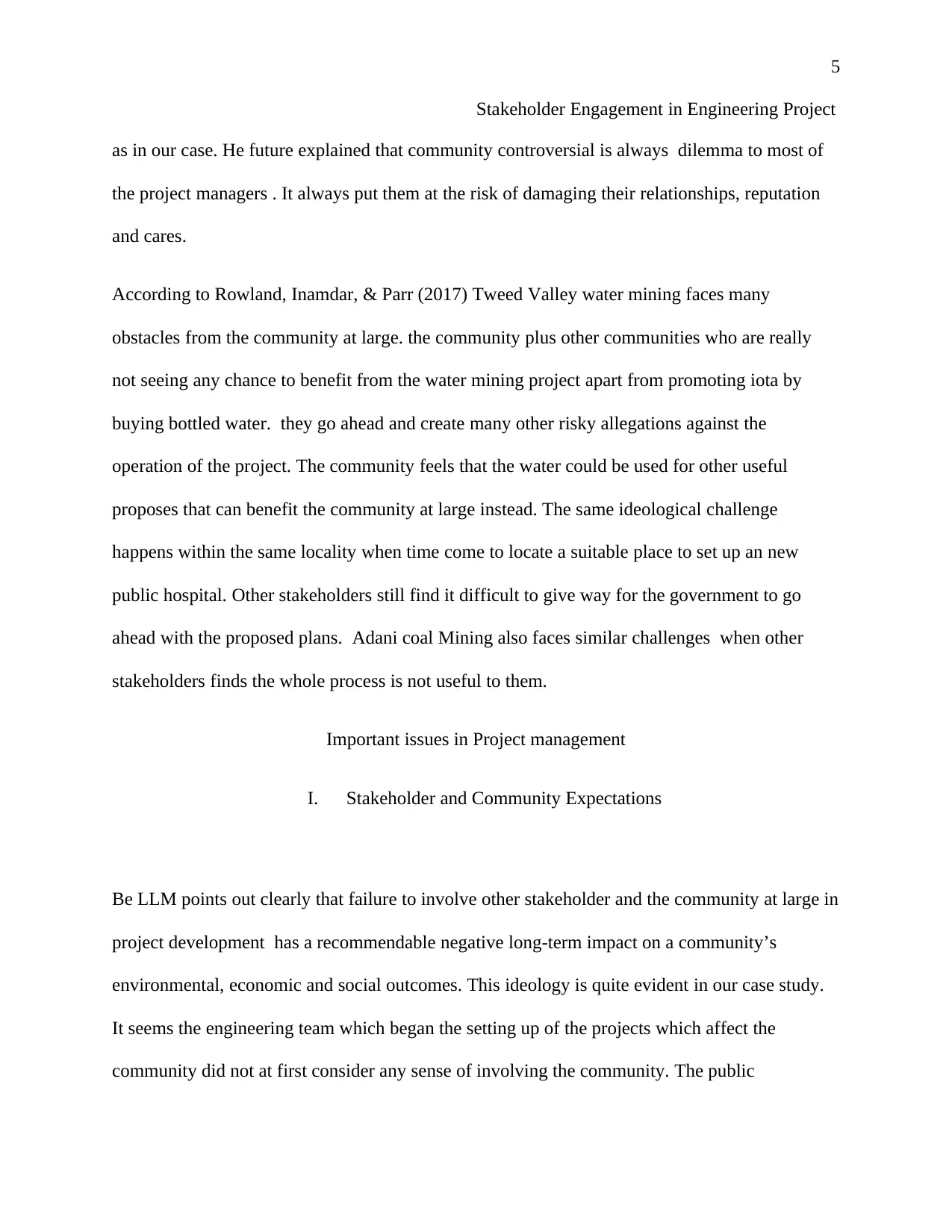
5
Stakeholder Engagement in Engineering Project
as in our case. He future explained that community controversial is always dilemma to most of
the project managers . It always put them at the risk of damaging their relationships, reputation
and cares.
According to Rowland, Inamdar, & Parr (2017) Tweed Valley water mining faces many
obstacles from the community at large. the community plus other communities who are really
not seeing any chance to benefit from the water mining project apart from promoting iota by
buying bottled water. they go ahead and create many other risky allegations against the
operation of the project. The community feels that the water could be used for other useful
proposes that can benefit the community at large instead. The same ideological challenge
happens within the same locality when time come to locate a suitable place to set up an new
public hospital. Other stakeholders still find it difficult to give way for the government to go
ahead with the proposed plans. Adani coal Mining also faces similar challenges when other
stakeholders finds the whole process is not useful to them.
Important issues in Project management
I. Stakeholder and Community Expectations
Be LLM points out clearly that failure to involve other stakeholder and the community at large in
project development has a recommendable negative long-term impact on a community’s
environmental, economic and social outcomes. This ideology is quite evident in our case study.
It seems the engineering team which began the setting up of the projects which affect the
community did not at first consider any sense of involving the community. The public
Stakeholder Engagement in Engineering Project
as in our case. He future explained that community controversial is always dilemma to most of
the project managers . It always put them at the risk of damaging their relationships, reputation
and cares.
According to Rowland, Inamdar, & Parr (2017) Tweed Valley water mining faces many
obstacles from the community at large. the community plus other communities who are really
not seeing any chance to benefit from the water mining project apart from promoting iota by
buying bottled water. they go ahead and create many other risky allegations against the
operation of the project. The community feels that the water could be used for other useful
proposes that can benefit the community at large instead. The same ideological challenge
happens within the same locality when time come to locate a suitable place to set up an new
public hospital. Other stakeholders still find it difficult to give way for the government to go
ahead with the proposed plans. Adani coal Mining also faces similar challenges when other
stakeholders finds the whole process is not useful to them.
Important issues in Project management
I. Stakeholder and Community Expectations
Be LLM points out clearly that failure to involve other stakeholder and the community at large in
project development has a recommendable negative long-term impact on a community’s
environmental, economic and social outcomes. This ideology is quite evident in our case study.
It seems the engineering team which began the setting up of the projects which affect the
community did not at first consider any sense of involving the community. The public
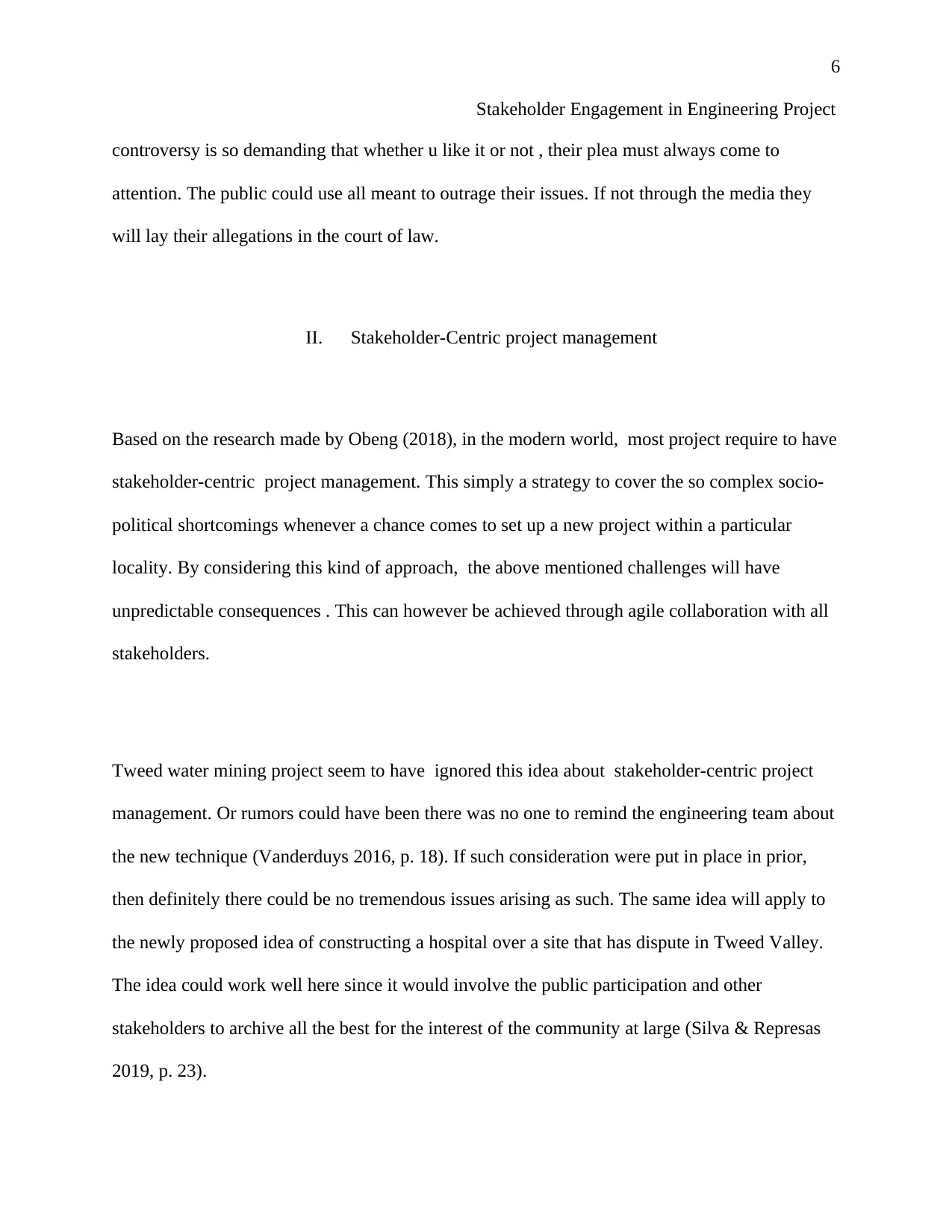
6
Stakeholder Engagement in Engineering Project
controversy is so demanding that whether u like it or not , their plea must always come to
attention. The public could use all meant to outrage their issues. If not through the media they
will lay their allegations in the court of law.
II. Stakeholder-Centric project management
Based on the research made by Obeng (2018), in the modern world, most project require to have
stakeholder-centric project management. This simply a strategy to cover the so complex socio-
political shortcomings whenever a chance comes to set up a new project within a particular
locality. By considering this kind of approach, the above mentioned challenges will have
unpredictable consequences . This can however be achieved through agile collaboration with all
stakeholders.
Tweed water mining project seem to have ignored this idea about stakeholder-centric project
management. Or rumors could have been there was no one to remind the engineering team about
the new technique (Vanderduys 2016, p. 18). If such consideration were put in place in prior,
then definitely there could be no tremendous issues arising as such. The same idea will apply to
the newly proposed idea of constructing a hospital over a site that has dispute in Tweed Valley.
The idea could work well here since it would involve the public participation and other
stakeholders to archive all the best for the interest of the community at large (Silva & Represas
2019, p. 23).
Stakeholder Engagement in Engineering Project
controversy is so demanding that whether u like it or not , their plea must always come to
attention. The public could use all meant to outrage their issues. If not through the media they
will lay their allegations in the court of law.
II. Stakeholder-Centric project management
Based on the research made by Obeng (2018), in the modern world, most project require to have
stakeholder-centric project management. This simply a strategy to cover the so complex socio-
political shortcomings whenever a chance comes to set up a new project within a particular
locality. By considering this kind of approach, the above mentioned challenges will have
unpredictable consequences . This can however be achieved through agile collaboration with all
stakeholders.
Tweed water mining project seem to have ignored this idea about stakeholder-centric project
management. Or rumors could have been there was no one to remind the engineering team about
the new technique (Vanderduys 2016, p. 18). If such consideration were put in place in prior,
then definitely there could be no tremendous issues arising as such. The same idea will apply to
the newly proposed idea of constructing a hospital over a site that has dispute in Tweed Valley.
The idea could work well here since it would involve the public participation and other
stakeholders to archive all the best for the interest of the community at large (Silva & Represas
2019, p. 23).
⊘ This is a preview!⊘
Do you want full access?
Subscribe today to unlock all pages.

Trusted by 1+ million students worldwide
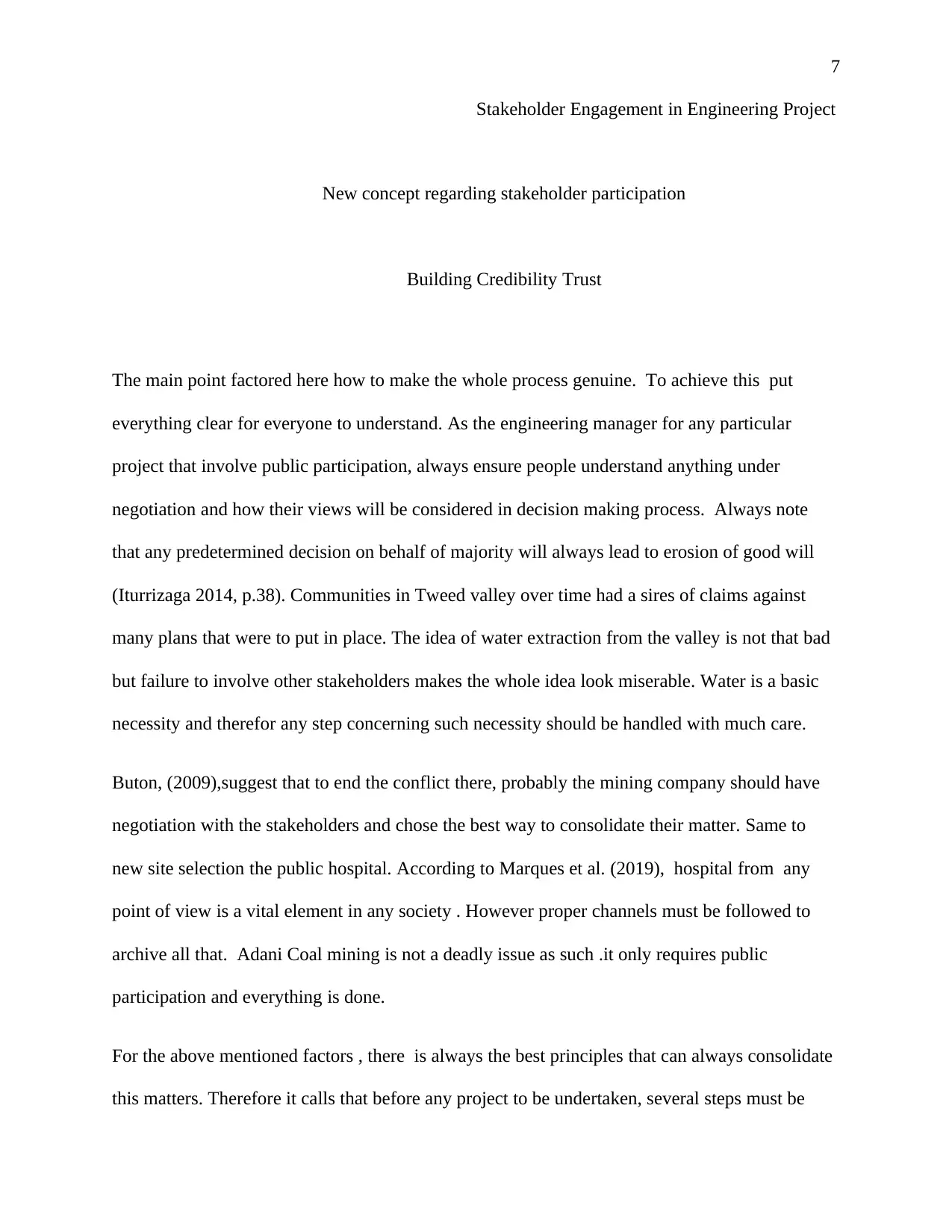
7
Stakeholder Engagement in Engineering Project
New concept regarding stakeholder participation
Building Credibility Trust
The main point factored here how to make the whole process genuine. To achieve this put
everything clear for everyone to understand. As the engineering manager for any particular
project that involve public participation, always ensure people understand anything under
negotiation and how their views will be considered in decision making process. Always note
that any predetermined decision on behalf of majority will always lead to erosion of good will
(Iturrizaga 2014, p.38). Communities in Tweed valley over time had a sires of claims against
many plans that were to put in place. The idea of water extraction from the valley is not that bad
but failure to involve other stakeholders makes the whole idea look miserable. Water is a basic
necessity and therefor any step concerning such necessity should be handled with much care.
Buton, (2009),suggest that to end the conflict there, probably the mining company should have
negotiation with the stakeholders and chose the best way to consolidate their matter. Same to
new site selection the public hospital. According to Marques et al. (2019), hospital from any
point of view is a vital element in any society . However proper channels must be followed to
archive all that. Adani Coal mining is not a deadly issue as such .it only requires public
participation and everything is done.
For the above mentioned factors , there is always the best principles that can always consolidate
this matters. Therefore it calls that before any project to be undertaken, several steps must be
Stakeholder Engagement in Engineering Project
New concept regarding stakeholder participation
Building Credibility Trust
The main point factored here how to make the whole process genuine. To achieve this put
everything clear for everyone to understand. As the engineering manager for any particular
project that involve public participation, always ensure people understand anything under
negotiation and how their views will be considered in decision making process. Always note
that any predetermined decision on behalf of majority will always lead to erosion of good will
(Iturrizaga 2014, p.38). Communities in Tweed valley over time had a sires of claims against
many plans that were to put in place. The idea of water extraction from the valley is not that bad
but failure to involve other stakeholders makes the whole idea look miserable. Water is a basic
necessity and therefor any step concerning such necessity should be handled with much care.
Buton, (2009),suggest that to end the conflict there, probably the mining company should have
negotiation with the stakeholders and chose the best way to consolidate their matter. Same to
new site selection the public hospital. According to Marques et al. (2019), hospital from any
point of view is a vital element in any society . However proper channels must be followed to
archive all that. Adani Coal mining is not a deadly issue as such .it only requires public
participation and everything is done.
For the above mentioned factors , there is always the best principles that can always consolidate
this matters. Therefore it calls that before any project to be undertaken, several steps must be
Paraphrase This Document
Need a fresh take? Get an instant paraphrase of this document with our AI Paraphraser
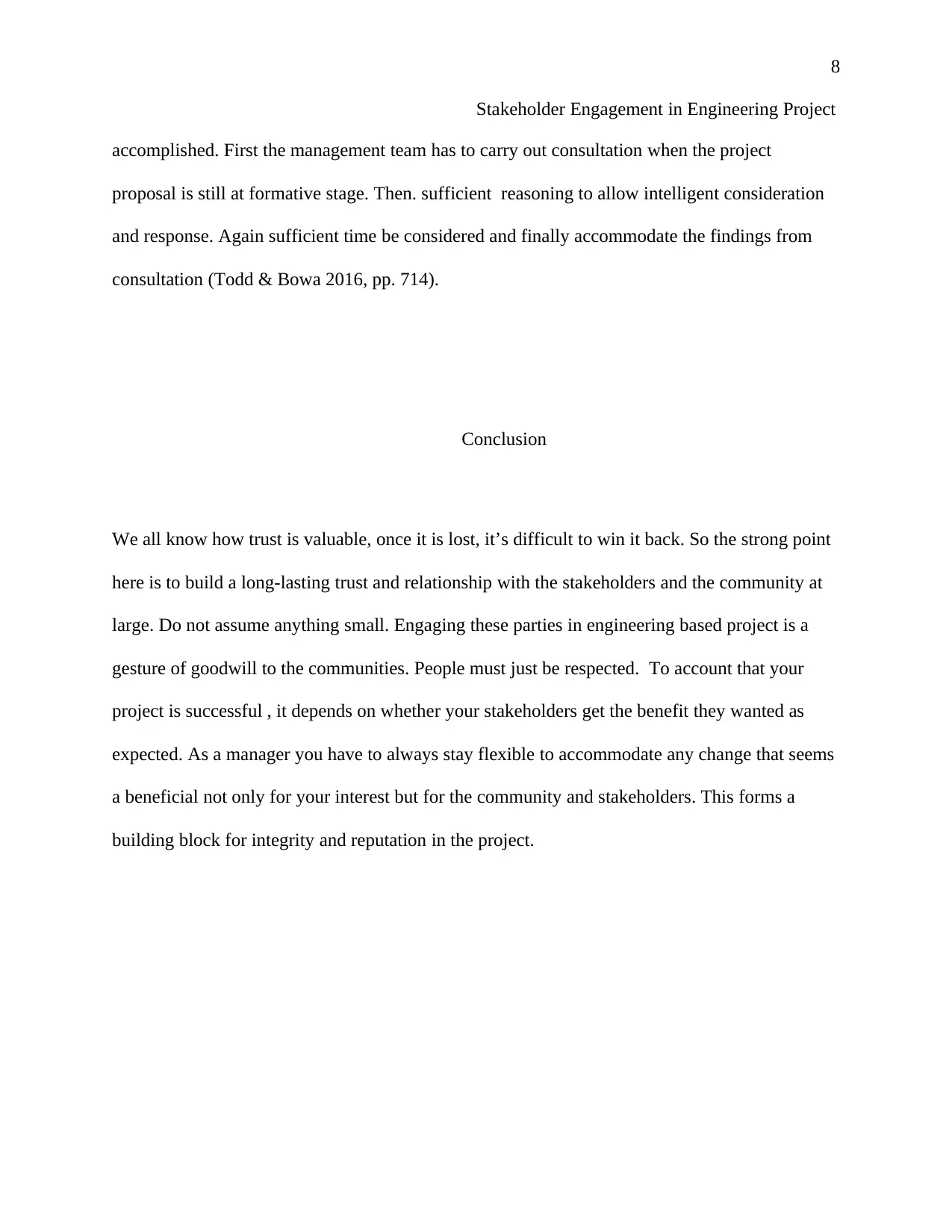
8
Stakeholder Engagement in Engineering Project
accomplished. First the management team has to carry out consultation when the project
proposal is still at formative stage. Then. sufficient reasoning to allow intelligent consideration
and response. Again sufficient time be considered and finally accommodate the findings from
consultation (Todd & Bowa 2016, pp. 714).
Conclusion
We all know how trust is valuable, once it is lost, it’s difficult to win it back. So the strong point
here is to build a long-lasting trust and relationship with the stakeholders and the community at
large. Do not assume anything small. Engaging these parties in engineering based project is a
gesture of goodwill to the communities. People must just be respected. To account that your
project is successful , it depends on whether your stakeholders get the benefit they wanted as
expected. As a manager you have to always stay flexible to accommodate any change that seems
a beneficial not only for your interest but for the community and stakeholders. This forms a
building block for integrity and reputation in the project.
Stakeholder Engagement in Engineering Project
accomplished. First the management team has to carry out consultation when the project
proposal is still at formative stage. Then. sufficient reasoning to allow intelligent consideration
and response. Again sufficient time be considered and finally accommodate the findings from
consultation (Todd & Bowa 2016, pp. 714).
Conclusion
We all know how trust is valuable, once it is lost, it’s difficult to win it back. So the strong point
here is to build a long-lasting trust and relationship with the stakeholders and the community at
large. Do not assume anything small. Engaging these parties in engineering based project is a
gesture of goodwill to the communities. People must just be respected. To account that your
project is successful , it depends on whether your stakeholders get the benefit they wanted as
expected. As a manager you have to always stay flexible to accommodate any change that seems
a beneficial not only for your interest but for the community and stakeholders. This forms a
building block for integrity and reputation in the project.
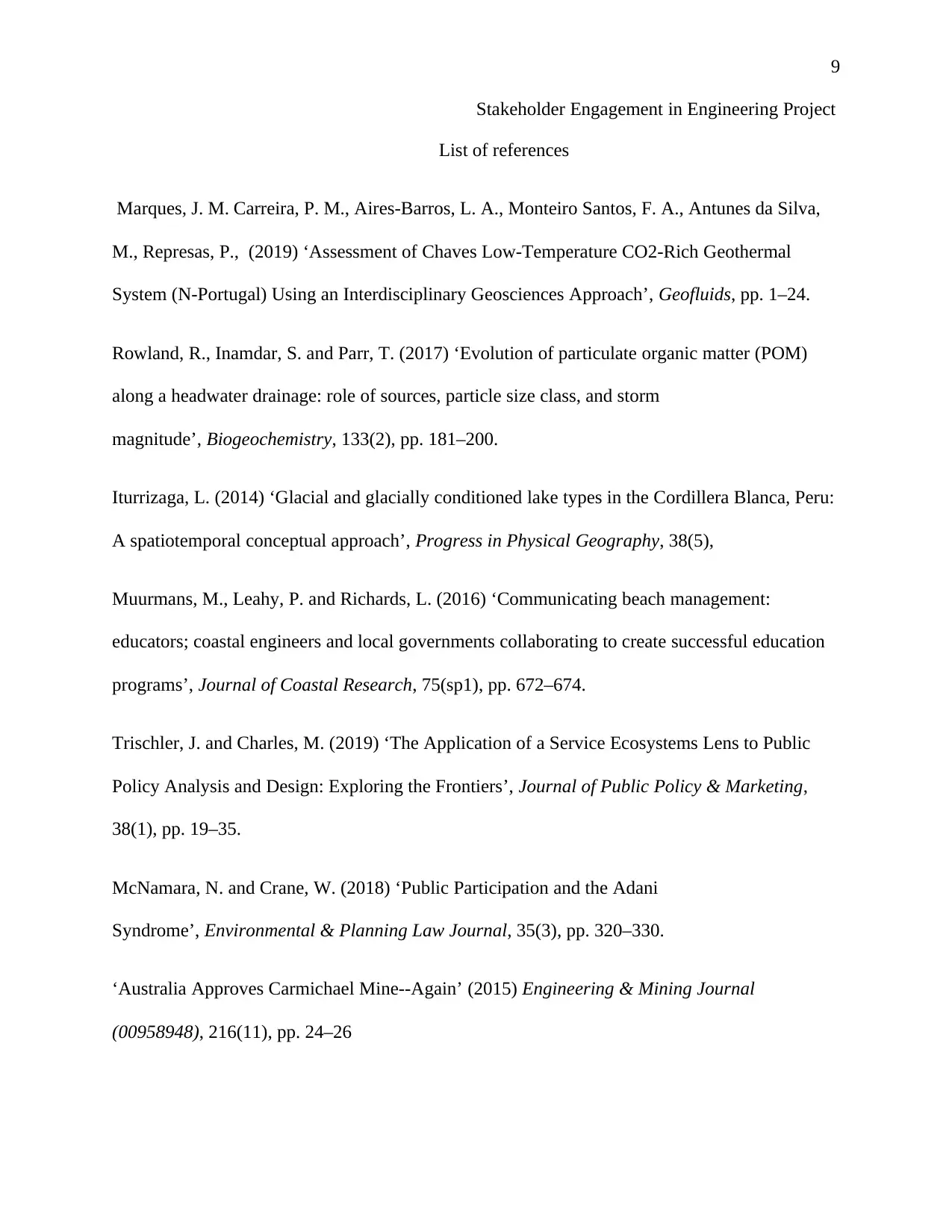
9
Stakeholder Engagement in Engineering Project
List of references
Marques, J. M. Carreira, P. M., Aires-Barros, L. A., Monteiro Santos, F. A., Antunes da Silva,
M., Represas, P., (2019) ‘Assessment of Chaves Low-Temperature CO2-Rich Geothermal
System (N-Portugal) Using an Interdisciplinary Geosciences Approach’, Geofluids, pp. 1–24.
Rowland, R., Inamdar, S. and Parr, T. (2017) ‘Evolution of particulate organic matter (POM)
along a headwater drainage: role of sources, particle size class, and storm
magnitude’, Biogeochemistry, 133(2), pp. 181–200.
Iturrizaga, L. (2014) ‘Glacial and glacially conditioned lake types in the Cordillera Blanca, Peru:
A spatiotemporal conceptual approach’, Progress in Physical Geography, 38(5),
Muurmans, M., Leahy, P. and Richards, L. (2016) ‘Communicating beach management:
educators; coastal engineers and local governments collaborating to create successful education
programs’, Journal of Coastal Research, 75(sp1), pp. 672–674.
Trischler, J. and Charles, M. (2019) ‘The Application of a Service Ecosystems Lens to Public
Policy Analysis and Design: Exploring the Frontiers’, Journal of Public Policy & Marketing,
38(1), pp. 19–35.
McNamara, N. and Crane, W. (2018) ‘Public Participation and the Adani
Syndrome’, Environmental & Planning Law Journal, 35(3), pp. 320–330.
‘Australia Approves Carmichael Mine--Again’ (2015) Engineering & Mining Journal
(00958948), 216(11), pp. 24–26
Stakeholder Engagement in Engineering Project
List of references
Marques, J. M. Carreira, P. M., Aires-Barros, L. A., Monteiro Santos, F. A., Antunes da Silva,
M., Represas, P., (2019) ‘Assessment of Chaves Low-Temperature CO2-Rich Geothermal
System (N-Portugal) Using an Interdisciplinary Geosciences Approach’, Geofluids, pp. 1–24.
Rowland, R., Inamdar, S. and Parr, T. (2017) ‘Evolution of particulate organic matter (POM)
along a headwater drainage: role of sources, particle size class, and storm
magnitude’, Biogeochemistry, 133(2), pp. 181–200.
Iturrizaga, L. (2014) ‘Glacial and glacially conditioned lake types in the Cordillera Blanca, Peru:
A spatiotemporal conceptual approach’, Progress in Physical Geography, 38(5),
Muurmans, M., Leahy, P. and Richards, L. (2016) ‘Communicating beach management:
educators; coastal engineers and local governments collaborating to create successful education
programs’, Journal of Coastal Research, 75(sp1), pp. 672–674.
Trischler, J. and Charles, M. (2019) ‘The Application of a Service Ecosystems Lens to Public
Policy Analysis and Design: Exploring the Frontiers’, Journal of Public Policy & Marketing,
38(1), pp. 19–35.
McNamara, N. and Crane, W. (2018) ‘Public Participation and the Adani
Syndrome’, Environmental & Planning Law Journal, 35(3), pp. 320–330.
‘Australia Approves Carmichael Mine--Again’ (2015) Engineering & Mining Journal
(00958948), 216(11), pp. 24–26
⊘ This is a preview!⊘
Do you want full access?
Subscribe today to unlock all pages.

Trusted by 1+ million students worldwide
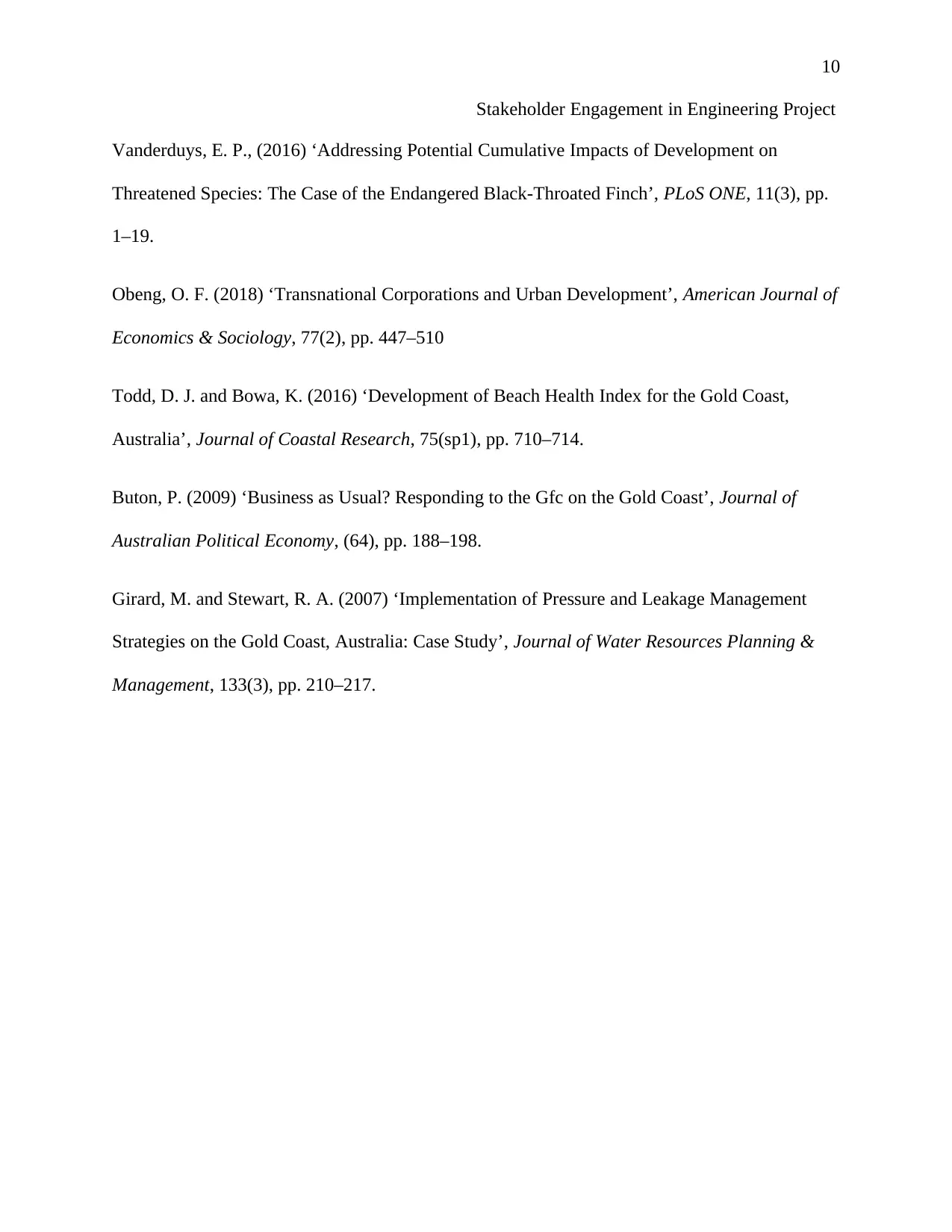
10
Stakeholder Engagement in Engineering Project
Vanderduys, E. P., (2016) ‘Addressing Potential Cumulative Impacts of Development on
Threatened Species: The Case of the Endangered Black-Throated Finch’, PLoS ONE, 11(3), pp.
1–19.
Obeng, O. F. (2018) ‘Transnational Corporations and Urban Development’, American Journal of
Economics & Sociology, 77(2), pp. 447–510
Todd, D. J. and Bowa, K. (2016) ‘Development of Beach Health Index for the Gold Coast,
Australia’, Journal of Coastal Research, 75(sp1), pp. 710–714.
Buton, P. (2009) ‘Business as Usual? Responding to the Gfc on the Gold Coast’, Journal of
Australian Political Economy, (64), pp. 188–198.
Girard, M. and Stewart, R. A. (2007) ‘Implementation of Pressure and Leakage Management
Strategies on the Gold Coast, Australia: Case Study’, Journal of Water Resources Planning &
Management, 133(3), pp. 210–217.
Stakeholder Engagement in Engineering Project
Vanderduys, E. P., (2016) ‘Addressing Potential Cumulative Impacts of Development on
Threatened Species: The Case of the Endangered Black-Throated Finch’, PLoS ONE, 11(3), pp.
1–19.
Obeng, O. F. (2018) ‘Transnational Corporations and Urban Development’, American Journal of
Economics & Sociology, 77(2), pp. 447–510
Todd, D. J. and Bowa, K. (2016) ‘Development of Beach Health Index for the Gold Coast,
Australia’, Journal of Coastal Research, 75(sp1), pp. 710–714.
Buton, P. (2009) ‘Business as Usual? Responding to the Gfc on the Gold Coast’, Journal of
Australian Political Economy, (64), pp. 188–198.
Girard, M. and Stewart, R. A. (2007) ‘Implementation of Pressure and Leakage Management
Strategies on the Gold Coast, Australia: Case Study’, Journal of Water Resources Planning &
Management, 133(3), pp. 210–217.
1 out of 10
Related Documents
Your All-in-One AI-Powered Toolkit for Academic Success.
+13062052269
info@desklib.com
Available 24*7 on WhatsApp / Email
![[object Object]](/_next/static/media/star-bottom.7253800d.svg)
Unlock your academic potential
Copyright © 2020–2025 A2Z Services. All Rights Reserved. Developed and managed by ZUCOL.





